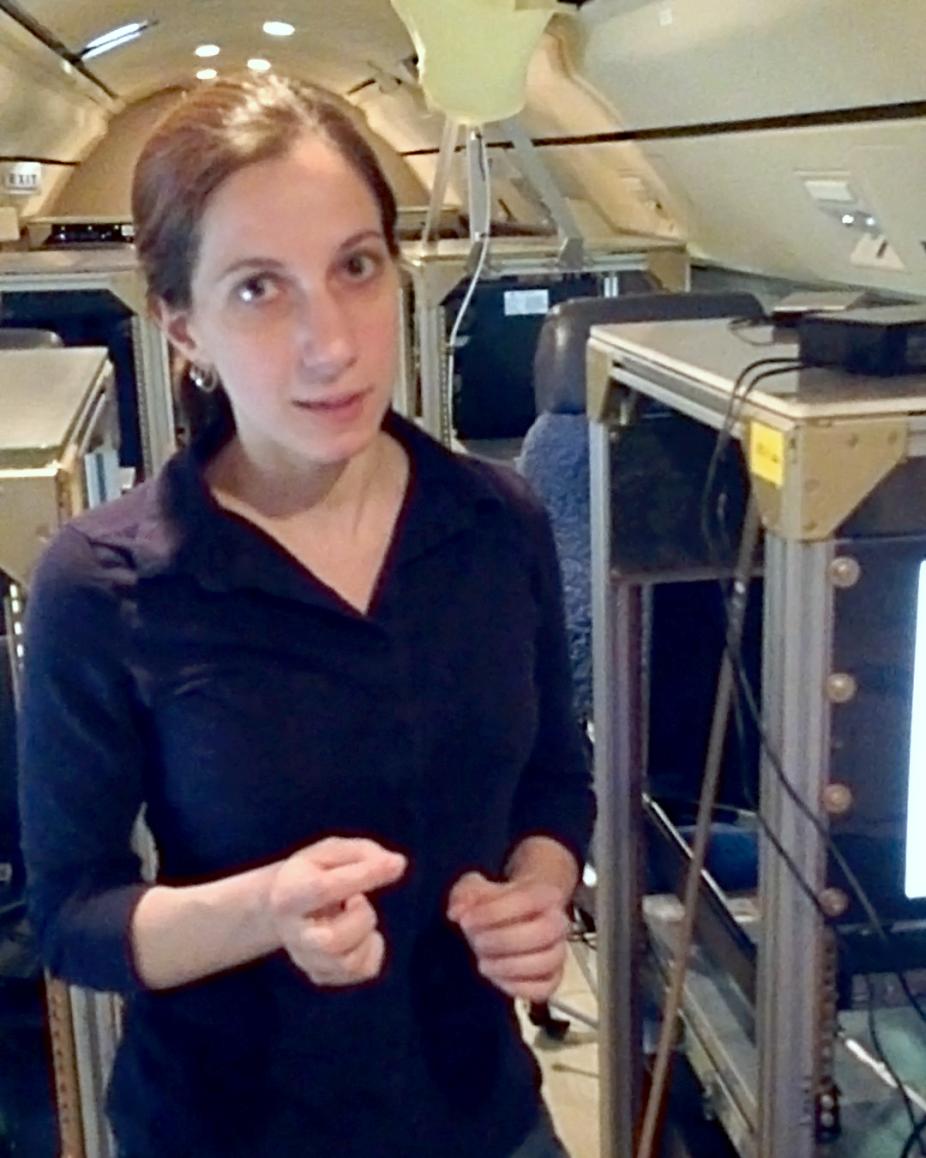Jenna Samra had a very extraordinary scientific research experience while visiting Colorado this summer. The recent August 21 total solar eclipse provided Jenna a unique opportunity to test an instrument that she helped design and build, the airborne infrared spectrometer or AIR-Spec.

Jenna Samra, taken on the Gulfstream V research aircraft.
Alexandra Witze
Even a non-scientist, like myself, was fascinated in hearing Jenna’s story about what led her to become interested in solar instrumentation and how that brought her to the flight that was the pivotal moment in her graduate research, and later to HAO to analyze the flight data. Here are some excerpts from what she told me:
“As a child, I liked math and science, and at college (Penn State), I majored in Electrical Engineering because it had elements of both subjects. I stayed at Penn State to get a master’s degree in Electrical Engineering and then started a job in applied research. While working, I got some experience with telescopes and spectrometers and developed an interest in optical instrumentation. That four-year work experience inspired me to begin a PhD at Harvard University, where I wanted to build instruments to research climate change. Two years into my PhD, I became interested in a project in the solar group at the Harvard-Smithsonian Center for Astrophysics (CfA). I am now finishing my thesis research on that project, which involved designing, building, and flying an instrument called the airborne infrared spectrometer or AIR-Spec.”
During the summer, 2017, Jenna was part of a Smithsonian Astrophysical Observatory team that flew AIR-Spec on the NSF/NCAR Gulfstream V research aircraft. The team flew their instrument during the August 21 total solar eclipse and took infrared spectroscopic measurements of the solar corona. After the eclipse, Jenna returned to Boulder to analyze the eclipse data with HAO’s Philip Judge, an expert in spectroscopy and coronal science. Jenna explained to me that the instrument was designed to observe five coronal emission lines, which were highlighted in Judge’s 1998 paper as potentially useful for measuring the coronal magnetic field. The team believes that AIR-Spec made the first measurement of one of these lines. Jenna and Phil will publish a discovery paper soon.
While Jenna was on her airborne mission, Phil Judge and others from HAO, located at Casper Mountain, Wyoming, were busy making ground-based observations using four instruments that observed visible and infrared light from the corona. These observations will complement the data recorded from the air.
I asked Jenna more about her air flight experience and she elaborated, “The reason we had to be on an airplane was because many of the infrared wavelengths …are absorbed by water, carbon dioxide, and other gases in the earth’s atmosphere. If we were on the ground, this light wouldn’t reach us, but we were flying at 47,000 feet, which is above most of the atmospheric absorption. That’s higher than commercial, but not much, and it doesn’t feel any different when you’re up there. We were in a jet known as a Gulfstream V, which is usually used as a corporate aircraft.” The Gulfstream V, owned by NSF, is located at NCAR’s Research Aviation Facility (RAF). It has undergone various changes to make it suitable for scientific research, including being outfitted with special optical-quality viewports.
She continued, “One of the things that was really challenging about flying instead of observing from the ground was dealing with the motion of the plane relative to the eclipse. Imagine looking out of the window and trying to focus on one point on the horizon—that point is going up and down, left, and right when you’re in an airplane. The plane’s motion was something we had to compensate for in order to make sure that we stayed pointed at the eclipse at all times. We developed a system that would correct for the motion of the plane and always keep the eclipse in the camera.”
The pressure was on, because they only had four minutes of eclipse time. They wouldn’t get any do-overs so they left nothing to chance and practiced flight tests all summer, tracking and measuring the sun over and over again. During totality her team was very busy aligning the Airborne Infrared Spectrometer, assessing the timing, and staying on course by communicating with the pilots. Jenna was watching the context camera, which showed a white light picture of the corona (a black and white image), and PI Ed DeLuca was looking for the spectral emission lines. At first Ed was unable to see any of the lines, because the data was dominated by noise from the high thermal instrument background. Although this was unsettling at the time, the team discovered later that data post processing—a lot of alignment and averaging—would reveal all of their target lines. Jenna’s conclusion? “…We got data and that’s exciting!” The data will help scientists design a future instrument to measure the coronal magnetic field.
After this amazing summer experience I wondered how Jenna would settle down to writing her PhD thesis. Her answer? “The writing is going to require a different kind of mindset that I’m not in yet, but I think that I will get there. There’s always a little hump to get over before the writing gets easier, but right now I’m more in data analysis/instrument building mode, so I just have to transition over.”
I have no doubt Jenna’s passion for her research will see her to completion and further her path to a promising and remarkable future career.